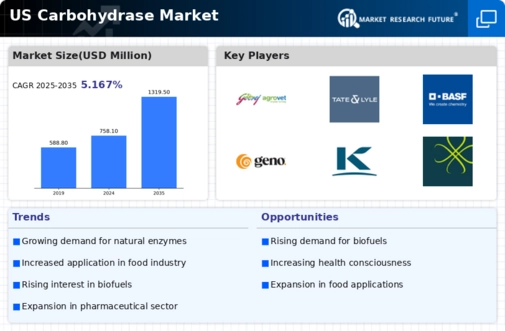The competitive landscape of the US Carbohydrase Market is characterized by a diverse range of players, each vying for market share through innovative product offerings and strategic initiatives. As the demand for enzymes continues to rise due to their essential role in various industries such as food and beverages, biofuel, and animal nutrition, companies are increasingly focusing on research and development to enhance their product portfolios. This market is marked by a combination of established players and emerging startups, leading to a dynamic competition driven by technological advancements, regulatory changes, and shifting consumer preferences.
The ongoing trend towards bio-based and environmentally friendly products has further intensified the competition, with companies looking to capitalize on sustainability as a core value proposition. Overall, the US Carbohydrase Market demonstrates a vibrant competitive environment, with firms continually adapting to align their strategies with market demands and consumer expectations.AB Enzymes has established a notable presence in the US Carbohydrase Market, leveraging its extensive expertise and innovative product solutions. The company has positioned itself as a leader in enzyme technology, focusing on developing tailored carbohydrases that meet specific industry needs.
One of the main strengths of AB Enzymes lies in its commitment to research and development, allowing the company to introduce high-performance products that enhance processing efficiency and improve product quality for various applications. Furthermore, AB Enzymes benefits from a robust distribution network and strategic partnerships, which contribute to its strong market presence in the US.
The company also emphasizes sustainability by providing enzyme solutions that facilitate the reduction of environmental impacts, aligning with the growing consumer preference for eco-friendly products.Godrej Agrovet plays a significant role in the US Carbohydrase Market, offering a range of enzyme products designed to serve the agricultural and food sectors. The company’s portfolio includes specialized carbohydrases that enhance feed digestibility and improve feed efficiency for livestock, thereby supporting the animal nutrition industry. Godrej Agrovet capitalizes on its broad market presence through strategic partnerships and collaborations, effectively expanding its distribution channels within the US.
One of the key strengths of the company is its focus on innovation, as highlighted by its investments in R&D leading to the development of cutting-edge enzyme solutions. In recent years, Godrej Agrovet has sought to enhance its market position through mergers and acquisitions, which have enabled it to expand its capabilities and product offerings in the enzymatic space. Through these strategies, Godrej Agrovet aims to maintain its competitive edge and address the evolving needs of the US Carbohydrase Market.


















Leave a Comment